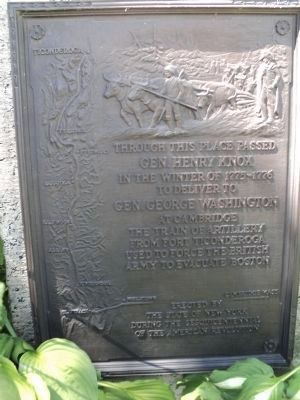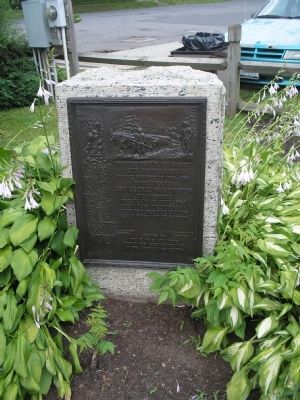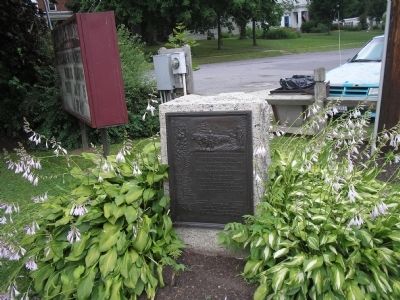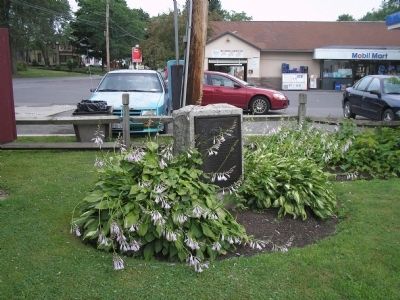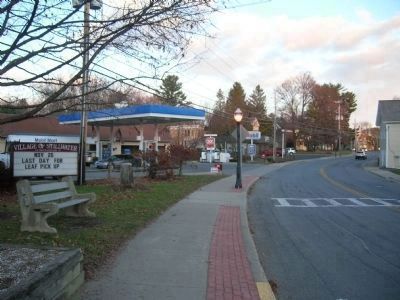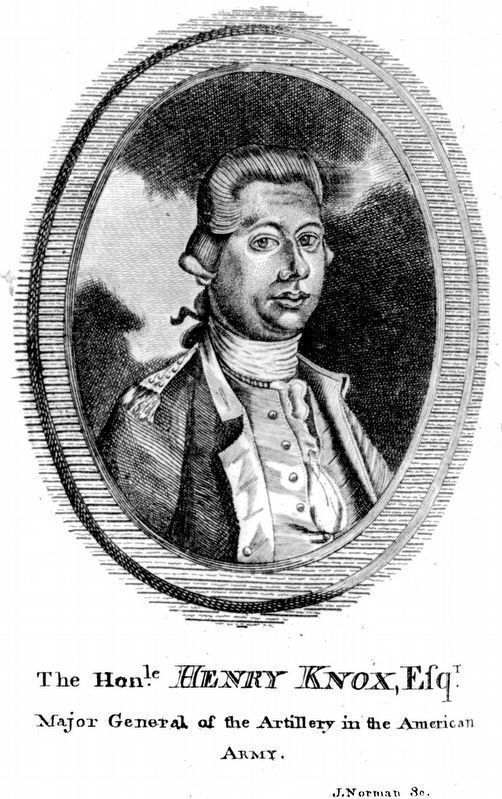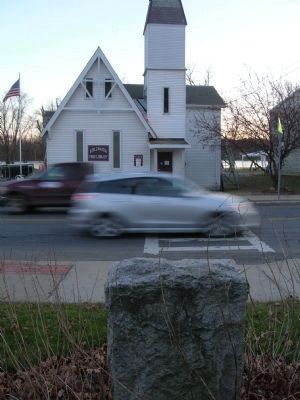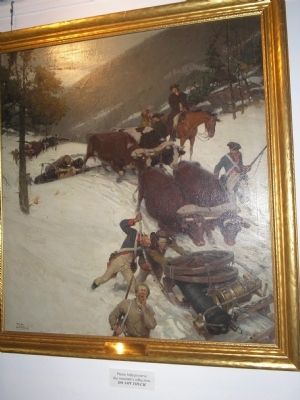Stillwater in Saratoga County, New York — The American Northeast (Mid-Atlantic)
Gen. Henry Knox Trail
Gen. Henry Knox
in the winter of 1775-1776
to deliver to
Gen. George Washington
at Cambridge
the train of artillery
from Fort Ticonderoga
used to force the British
Army to evacuate Boston
Erected by
The State of New York
during the sesquicentennial
of the American Revolution
Erected 1926 by State of New York. (Marker Number NY-16.)
Topics and series. This historical marker is listed in these topic lists: Military • Notable Events • Notable Places • War, US Revolutionary. In addition, it is included in the Former U.S. Presidents: #01 George Washington, and the General Henry Knox Trail series lists.
Location. 42° 56.262′ N, 73° 39.515′ W. Marker is in Stillwater, New York, in Saratoga County. Marker is on Hudson Avenue (U.S. 4), on the right when traveling south. The Gen. Henry Knox Marker Marker is directly across South Hudson Ave from the Stillwater Free Library, which is housed in a former St. John’s Episcopal Church (1874) building. Touch for map. Marker is in this post office area: Stillwater NY 12170, United States of America. Touch for directions.
Other nearby markers. At least 8 other markers are within walking distance of this marker. Stillwater World War I Memorial (within shouting distance of this marker); Site of Schuyler Mansion (about 300 feet away, measured in a direct line); Harmanus Schuyler Mansion (about 300 feet away); Stillwater Blockhouse (about 600 feet away); The Academy (approx. ¼ mile away); United Church (approx. ¼ mile away); Historic Sites (approx. half a mile away); Dirck Swart House (approx. half a mile away). Touch for a list and map of all markers in Stillwater.
More about this marker. The top of the marker contains a relief scene of Gen. Knox overseeing several teams of oxen dragging the artillery pieces. The left of the marker contains a map tracing the route taken from Ticonderoga to Cambridge, Mass. Indicated along the route are the New York towns of Ft. George, Ft. Edward, Saratoga, Half Moon, Albany, Kinderhook, Claverack and Nobletown.
Regarding Gen. Henry Knox Trail. The Henry Knox Cannon Trail denotes the path followed by Colonel Knox and his men from December 1775 to January 1776 to transport 59 captured weapon pieces from Fort Ticonderoga and Crown Point on Lake Champlain, New York to General
George Washington at Dorchester Heights overlooking Boston, Massachusetts.
This pivotal event of the American Revolution resulted in the evacuation of British soldiers from Boston.
The Advisory Board on Battlefields and Historic Sites recommended that the state of New York purchase 30 granite markers in identical pattern, each with a bronze tablet featuring a map of the trail, an image in relief of cannon being dragged by ox sled through the snow, and the words:
"Through this place passed General Henry Knox in the winter of 1775 - 1776 to deliver to General George Washington at Cambridge the Train of Artillery from Fort Ticonderoga used to force the British army to evacuate Boston. Erected by the State of New York 1927."
In all, 30 of the bronze plaques are in New York State and 26 in Massachusetts. They represent the 56-day journey of American troops from Fort Ticonderoga to Boston.
The monuments were erected beginning in 1926, during the commemoration of the 150-year anniversary of the American Revolution, and completed in 1927. The trail is one of the earliest heritage paths created in the United States.
According to the Hudson River Valley Institute website, General Washington believed he could dislodge the British from the city, and dispatched Henry Knox, a 25-year-old Boston bookseller, to organize transportation of the captured
artillery pieces from Lake Champlain forts to the heights overlooking Boston in the winter of 1775. The British had occupied Boston since their victory in the Battle of Bunker Hill.
Henry Knox arrived at Fort Ticonderoga on the evening of December 5, 1775 accompanied by his 19-year-old brother William and a servant, Miller. Early the next day, assisted by the garrison of Fort Ticonderoga, he began to move the guns, including 43 heavy brass and iron cannons, 6 coehorns, 8 mortars and 2 howitzers.
In the second week of March, 1776, four months before the Declaration of Independence was signed, General Washington was ready to bombard the British in Boston from Dorchester Heights, using the array of heavy guns General Knox had laboriously dragged from Lake Champlain.
Lord William Howe recognized that only the evacuation of his army could save it, and on March 18 the victorious American army marched into the deserted city.
Related markers. Click here for a list of markers that are related to this marker. These markers follow the route used by Knox to transfer cannons from Fort Ticonderoga to Cambridge, Mass.
Also see . . .
1. The Henry Knox Canon Trail. New York State Conservation Department. (Submitted on August 1, 2008, by Bill Coughlin of Woodland Park, New Jersey.)
2. The Knox Trail - Heritage Tour Guide. The Hudson River Valley Institute. (Submitted on August 1, 2008, by Bill Coughlin of Woodland Park, New Jersey.)
3. Major General Henry Knox. Knox biography from the American Revolution website. (Submitted on August 1, 2008, by Bill Coughlin of Woodland Park, New Jersey.)
Credits. This page was last revised on January 11, 2024. It was originally submitted on August 1, 2008, by Bill Coughlin of Woodland Park, New Jersey. This page has been viewed 1,368 times since then and 29 times this year. Last updated on October 27, 2009, by Howard C. Ohlhous of Duanesburg, New York. Photos: 1. submitted on June 29, 2012, by Bill Coughlin of Woodland Park, New Jersey. 2, 3, 4. submitted on August 1, 2008, by Bill Coughlin of Woodland Park, New Jersey. 5. submitted on October 27, 2009, by Howard C. Ohlhous of Duanesburg, New York. 6. submitted on December 26, 2023, by Allen C. Browne of Silver Spring, Maryland. 7. submitted on October 27, 2009, by Howard C. Ohlhous of Duanesburg, New York. 8. submitted on August 1, 2008, by Bill Coughlin of Woodland Park, New Jersey. • Kevin W. was the editor who published this page.
